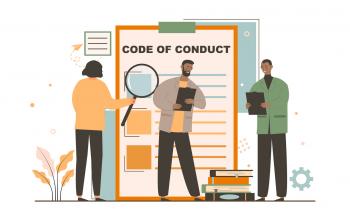The Village Employee Assistance Program offers expert advice to help you with some of the most challenging supervision issues. Click the links below to learn more about each topic.
- Constructive Confrontation
- Helping an Abused Employee
- Legal Issues in Supervision
- Off-Duty Activities
- Substance Abuse
- Incorporating Supervisor Referrals Into Performance Management
- Identifying Troubled Employees
- Supporting an Employee with Safety Concerns or Suicidal Ideation
READ MORE: Explore a collection of blogs on issues related to today's workplace >
For further assistance, consult your Supervisor Guide or contact the Supervisor Helpline at 1-800-627-8220.


Constructive Confrontation
As a supervisor, you are responsible for maintaining the productivity of your employees. When productivity of an employee doesn’t meet standards, it is your job to correct the situation. Confronting an employee whose work performance is declining is not easy. The “constructive confrontation” techniques outlined in the following links will help you improve the quality and results of the interactions you have with your employees.
Identifying the Cause
In many cases, declining work performance is directly related to an employee’s problems outside the office. By watching for the following changes in an employee’s behavior, you may notice that a personal problem exists.
- On more than one occasion the employee arrives at work or returns to work in an obviously impaired condition.
- Employee is frequently absent, returns late from lunch, leaves workstation without reason, makes many trips to the restroom.
- Personality changes (argumentative, quiet, unusually sensitive, borrows money, etc.)
- An increase in the employee’s accident rate, both on and off the job. Quality of work suffers (late assignments, errors, bad judgment, erratic work patterns, customer complaints).
- Change in circle of friends, or the employee suddenly seems to have no friends.
- Employee refuses to follow company policy.
In other cases, an employee’s decreased performance is due to job-related issues. Before talking with the employee, explore job-related issues that may be affecting your employee’s ability to meet your expectations. Ask yourself the following questions:
- Is the employee unclear about job expectations?
- Is the assigned job too difficult for the employee?
- Did you give the employee the proper tools and environment to complete the project?
- Are you, as the manager, contributing to your employee’s inability to perform the job adequately?
Regardless of the cause, personal problems or job-related issues, you must deal with poor job performance at once. Covering for the employee, handling his or her assignments, or passing them onto others will not make the problem go away. You’ll be doing yourself, your company and the employee a favor by confronting the issues as soon as they arise.
Preparing to Confront an Employee
One of the worst mistakes managers make is going into a performance meeting unprepared. Take the following steps to prepare for your next performance meeting.
- Prepare a written document listing the employee’s specific performance problems. Include date, times, specific numbers in regard to absenteeism and tardiness and specific examples of accidents or complaints.
- Outline your objectives. Determine specific objectives for the employee to accomplish and the date you will meet to further review performance.
- Organize information into easily referenced notes. It is easy to get sidetracked during a tension-filled meeting. Having notes will help you stay on track and keep you focused on your objective.
- Anticipate the employee’s reaction. Managers generally know their employees well enough to predict their reactions. Are they likely to be aggressive, defensive, non-communicative, etc.?
Set the time and location of the meeting. Schedule the meeting as close to the performance issue as possible. Hold the meeting in a neutral, non-threatening location where you will not be disturbed by noise, phone calls, etc.
Conducting the Meeting
Polishing up on your communication skills will help make the interaction easier for both you and the employee. As a supervisor, you can have a “destructive confrontation” or “constructive confrontation.” Destructive confrontation results in little action, no action or negative action. Too often, unintentional destructive behaviors and comments enter the interaction. These include:
- Minimizing or trying to soft-sell the problem
- Not getting to the point (talking around the problem)
- Acting apologetic
- Antagonizing the employee
- Letting the employee control the interview
- Letting friendship get in the way
- Not sticking to the facts and objectives
- Asking simple “yes” and “no” questions
- Mentioning problems without offering solutions
Constructive confrontation, on the other hand, results in a positive action where both parties leave the meeting with a clear understanding of what they are expected to do. Here are some guidelines for conducting a constructive confrontation.
Set the tone. Establish control immediately by expressing a confident tone of voice. Make eye contact with the employee, maintain confident body posture, and avoid small talk.
State the facts. Read the list of documented performance problems. Provide specific examples of absenteeism, tardiness, complaints, production, etc. If the employee has had good performance in the past, acknowledge it. “I know you have the potential to be successful in this position because you have been in the past. You need to come back to that.”
Encourage the employee to respond. Ask open-ended questions to get more than a “yes” or “no” answer. “Tell me about...” “What is it at work that gets in the way?” Rephrase employee’s statements, e.g., “Let me see if I got this right...?”
Keep the discussion focused. If the employee tries to sidetrack an issue, acknowledge his comment, but immediately bring the discussion back under your control. “That’s interesting, but we are here to talk about ... “
Discuss solutions. Cover your list of specific objectives. Ask for the employee’s input. For example, “What suggestions do you have for improving the situation?” Explain disciplinary procedures if they don’t improve the situation. Remember it is your job to get your employees to do the work they were hired to do.
Get a commitment. Directly ask the employee if she is willing to accomplish the objectives. “From now on, can I count on you to ...?”
Set up the next meeting. Advise the employee of the next performance review. Setting up another meeting will help assure that the employee feels accountable for his actions.
End on a positive note. Offer sincere encouragement that the problems can be worked out. For example, “I know you have it in you because I’ve seen it before.”
For most managers, confronting employees regarding performance issues is the hardest part of the job. As difficult as it is, learning to constructively confront performance issues can be the best thing you do for your employees. Most employees know when they aren’t living up to expectations and live in fear of “being caught.” Addressing the issue immediately with openness, honesty and respect can help alleviate the stress employees are under when not meeting performance standards. Allow them to focus on getting back on track.

Helping an Abused Employee
Knowing the impact of abuse on work performance and developing policies to make your workplace free from harassment and assaultive behaviors are important steps in preventing and dealing with abuse. But, the real test comes when employees show up in your office bruised and battered and tell you they are afraid to go home.
It is important to have some practical ways of responding to the needs of abused employees. Your response needs to take into consideration the situation at hand and stay focused on the primary goal of safety. This may mean putting aside your own preconceived ideas about abuse. Although the majority of victims are female, it is not uncommon for males to be victims of abuse. In short, both the victims and perpetrators of abuse come in all shapes, sizes, genders, religions, cultures, and professions. The first thing to do to effectively help abused employees is to not become judgmental when they admit to being abused.
The following guidelines will help you assist abused employees. Employees will present their own set of circumstances so you will need to use your discretion on how and when recommendations are implemented.
- When employees tell you they are being abused, resist the immediate temptation to minimize or fix the problem. Rather, focus on listening and asking questions that will help you get more information about the situation. The information you get will likely be very helpful in providing for their safety and determining if a safety threat exists for other employees.
- In cases where an employee admits to having recently been sexually or physically assaulted and has not already sought medical attention, make arrangements for him/her to get to an emergency room (ER) for an evaluation. If necessary, approve time off, make arrangements for someone to cover the job, and provide for safe transport to an ER.
- If you suspect that an employee is being abused (i.e. bruises, black eyes, red marks, comments to co-workers, etc.) hold a private meeting with the individual. State your concerns, listen to responses, and indicate your desire to help him/her be safe and able to perform the job.
- In situations where an employee is not at immediate risk of further abuse (i.e. already in a safe house, restraining order in place, perpetrator in jail etc.) and there are no apparent job performance issues, an informal referral to The Village Employee Assistance Program may suffice. Indicate to the employee that EAP counselors work with victims of abuse and can help. Provide the EAP phone number – 1-800-627-8220 – to make it easy to make contact.
- In situations where an employee is not at immediate risk of further abuse, but job performance issues could be attributed to being in an abusive situation (i.e. absenteeism, safety violations, difficulty attending to work, etc.), it may be necessary for you to make a formal referral to The Village EAP. Remember the referral can only speak to, and be based on, job performance issues.
- When an employee indicates he/she is at risk of further abuse or unsure of safety, it may be necessary to take some or all of the following steps:
- Call a shelter and make arrangements for the employee and/or other family members to have a safe place to stay. Call your county social services or local police department for the phone numbers of local shelter.
- If employee’s emergency contact person is not the abuse perpetrator, contact that person. This person may be able to provide for or help make arrangements for the employee’s safety.
- In any situation where there is imminent risk of harm to an abused employee, their family, and/or co-workers, contact the sheriff’s department immediately.
- Remain in contact with the employee and make arrangements to ensure safety at the work site (i.e. offer flexible work hours to reduce perpetrator’s ability to pattern behavior, provide security escorts to their car or other transportation, don’t allow perpetrator on company property, give time off to attend court hearings or go to counseling, etc.).
- Regardless of the particular situation, remind the abused employee of The Village Employee Assistance Program benefit and the availability of free help.
It is also very important to take care of yourself. As a manager, HR professional or supervisor, you may begin to feel the strain. The risk of “vicarious traumatization” leading to physical and emotional stress reactions can and does happen to managers and supervisors who have to deal with the trauma experienced by their employees. The Supervisor Helpline, Crisis Management Services, Counseling Services, and Executive Coaching are all tools managers and supervisors can use to help cope with distressing situations.

Legal Issues in Supervision
Do you ever get the feeling that supervising people in today’s workplace is like navigating a legal minefield? Many supervisors are concerned that daily business decisions regarding employees will backfire into a legal problem. Terminations, corrective actions, decisions about employee leave and even daily supervisory tasks like directing employees on correct work attire and attitude on the job have been the source of legal challenges by disgruntled employees.
Another source of supervisory concern involves compliance with the many laws that make discriminatory conduct unlawful. These include state and federal laws prohibiting discrimination on the basis of sex, age, race, religion, disability and other bases. Supervisors who are confident that they acted without discrimination often lack confidence that investigations, disciplinary actions and day-to-day decisions regarding employees will pass legal review if an employee makes a complaint of discrimination.
The laws themselves give limited practical guidance for supervisors on how to deal with day-to-day issues. Some of the laws have supporting regulations developed by agencies such as the Department of Labor and the Equal Employment Opportunity Commission. While these regulations include detailed recommendations of how to comply with the nondiscrimination laws, many times the courts who eventually decide employee legal complaints are not required to apply the regulations as if they were law. As a result of legal interpretation issues, much of the practical guidance to supervisors on compliance with the law is developed by lawyers and human resources professionals who review existing court decisions along with any regulatory guidance provided by agencies. The professionals attempt to meld the sometimes differing points of view into practical guidance. Even these practical guidelines do not cover every situation.
There are no guarantees that a particular course of action will always prevent employee lawsuits but you can adopt good practices and habits that will minimize the likelihood of unexpected legal challenges to your supervisory actions:
Accept that legal compliance is necessary to your success as a supervisor. Understanding regulations and legal requirements may be a chore at times but it is a necessary part of the supervisory role. Just as it is part of your job to protect company assets such as equipment, it is part of your job to protect the company from liability.
Actively support a culture of respect and professionalism in the workplace. Managers and supervisors need to lead by example to set the workplace tone of respect for co-workers. Lawsuits happen when people perceive that they have not been treated with respect and dignity. When respect is part of the organization’s culture, fewer legal issues arise.
Understand and implement appropriate policies. If you don’t understand a policy, the employees you supervise probably won’t either. Ask questions. Get clarity. Apply policies consistently. Follow your organization’s procedures for disciplinary actions including seeking appropriate consultation. If you aren’t sure about something, ask human resources or senior management. If it is an action that has a potential for legal liability, the organization may choose to seek legal counsel before proceeding.
Maintain appropriate documentation of all employee corrective actions. Don’t just focus on carefully documenting actions involving employees you think may be trouble down the road. Consistent and effective application of company policies is best demonstrated by good documentation in all the employee actions, not just the actions involving a particular employee.
Attend training on legal and regulatory issues. Training on sexual harassment prevention, drug-free workplace, diversity, and employment law related matters equips you to better do your job. The Employee Assistance Program (EAP), a program of The Village Family Service Center, can help your organization identify training needs and can provide training on a variety of issues.

Off-Duty Activities
Some of us react to an employee engaging in “questionable” off-duty conduct by intervening and trying to control or stop the behavior. Others bury their heads in the sand and pretend they don’t know anything about the questionable conduct. Either of these responses may be appropriate or inappropriate, depending on the situation. What an employer can and cannot do often depends on federal, state, county and municipal laws, statutes and ordinances, collective bargaining agreements and pertinent case law.
George F. Galland, Jr., a Chicago attorney, says, “You’re probably taking some risk when you start poking your nose into your employees’ private lives, deciding if they’re virtuous enough to work for you and then holding it against them at work. That’s something the average person thinks is wrong, and the law usually follows the public’s thinking.”
A Balancing Act
When dealing with questionable off-duty conduct, you must balance both employee and employer interests. Many courts have ruled that employers may invade an employee’s privacy if there is legitimate business and/or employment reasons – these reasons may include a conflict of interest, an employee in a confidential or sensitive management position, or acts that endangered, injured, or jeopardized the employer’s legitimate business interests. In other words, your right to do anything about an employee’s off-duty conduct often depends on the relationship between the conduct and the employee’s job and/or your company. When faced with a situation like this, ask yourself the following questions:
- Is there a connection between the off-duty conduct and the employee’s on-the-job performance?
- Does the off-duty conduct publicly affect your company negatively?
- Is it necessary to the well-being of your company to interfere in the employee’s private life?
- In some states, statutes protect an employee’s privacy rights unless the employer can show a bona fide occupational requirement for the restriction or a reasonable and rational relation between the restriction and the activities and responsibilities of the particular employee.
Ramifications
Employers who cross the line in dealing with off-duty conduct may find themselves entangled in a legal mess. In addition to legal concerns, interfering in your employees’ private lives can create resentment. If employees feel as though you have violated privacy rights, you may be faced with morale, productivity and retention issues. Further, how you handle these sensitive issues can have a long-term affect on your credibility, both among your staff and in the community.
Tips
- Tread cautiously when dealing with employee’s off-duty conduct. Don’t jump to conclusions or make rash decisions.
- Have well-written and clear company policies that guide employee conduct.
- Train and educate managers about the areas of off-duty behavior or lifestyles that can and can’t be addressed.
- Familiarize yourself with applicable laws pertaining to off-duty behaviors.
- Remember – although many states have varying statutes on off-duty conduct, as a general rule, marital status, children and religion are entitled to remain private.
- Always work with a competent attorney when confronted by off-duty conduct situations.

Substance Abuse
Effect on Work Environment
According to a recent survey, an estimated 14.8 million Americans are current illegal drug users. What does this statistic have to do with your workplace? The fact is, most individuals who abuse drugs or alcohol are also employed. And when they show up for work, many bring their problems with them.
How Drugs/Alcohol Can Affect Your Work Environment
Employees who use drugs can cost your company big, both financially and emotionally. Frequent absences, high illness rates, low morale, increased accidents, and low productivity are just some of the problems associated with substance abuse. These issues affect everyone – employers, co-workers, managers and customers. Consider these numbers:
- One out of every five employees state that they have had to redo work, work harder, cover for another employee, or have been put in a dangerous situation because of a co-worker’s drinking or drug use.
- Alcoholism accounts for 500 million missed workdays per year.
- Employees who currently use illegal drugs are more than twice as likely to change employers three or more times in one year.
- Up to 40% of industrial fatalities and 47% of industrial injuries can be attributed to alcoholism or alcohol use.
- 75% of callers to the National Cocaine Helpline have admitted to using drugs on the job while 44% have sold drugs to co-workers.
For assistance in helping employees with alcohol or drug issues, contact us online or call The Village Employee Assistance Program at 1-800-627-8220.

Incorporating Supervisor Referrals into Performance Management
As a supervisor or manager, you are destined to be faced with the issue of performance problems at one time or another. Employees do not always perform as well as you expect them to – there may be conflicts between co-workers, employees may come to work late or leave early, they may have personal problems that affect work performance, or there may be signs of substance abuse.
If you see signs of deteriorating performance, and would like input or an outside perspective on the situation, our Supervisor Helpline – 1-800-627-8220 – is a valuable resource. Every day we get calls from supervisors looking for advice on how to address various performance or employee issues. Most cases are related to communication problems, conflicts with co-workers or supervisors, excessive absenteeism, unacceptable quantity or quality of work, or drug-free workplace or DOT violations.
When intervening, you should always know the facts in the case before deciding your course of action, and prepare for the meeting with the employee by comparing actual performance to your expectations and the employee’s written job description. Defining the specific discrepancies between what is stated in the job performance and actual behavior and performance creates an objective norm or standard, which may simplify the issues and create a rationale for addressing them.
Based on the severity and extent of the performance issue at hand, we may recommend a Supervisor Referral to The Village's Employee Assistance Program; an effective tool and resource for supervisors. You can make two types of referrals – informal supervisor referrals and formal supervisor referrals.
When employees volunteer information about personal stress or problems, yet there is no deterioration in job performance, an Informal Supervisor Referral may be appropriate. Since there are no adverse effects on work performance, the situation calls for minimal supervisor intervention, if any. What you can do, however, is to remind the employee about the benefits available through The Village EAP, and also provide information on how to access these benefits (call 1-800-627-8220 or 701-451-4900). An informal referral allows you to offer assistance and resources, while maintaining a professional relationship with the employee, and avoiding involvement in the employee’s personal life.
If performance is deteriorating, or if there is a drug-free workplace violation, a Formal Supervisor Referral to The Village EAP is appropriate. A formal referral is a good way to connect employees with professionals trained and experienced in diagnosing and treating personal, professional, or substance abuse problems or issues. Employees are given a chance to face the problem, take ownership of the situation, and learn tools and techniques to help deal with and overcome the specific challenge. By making a formal referral to The Village's EAP, a supervisor can take advantage of external expertise in dealing with the performance problems.
The supervisor is kept informed about the employee’s attendance, compliance with recommendations, possible referrals to supplemental resources or treatment programs, or other significant changes or developments. This allows for the coordination of external and internal resources in addressing performance or drug-free workplace issues, and for finding new avenues to improving employee performance, attitude, and behavior.
The Supervisor Helpline and Informal and Formal Supervisor Referral services are included in most Village EAP contracts. For more information, contact us online or call The Village Employee Assistance Program at 1-800-627-8220.

Identifying Troubled Employees
As a supervisor, it is your job to ensure that staff are working up to their capacity. You can begin by learning how to determine who needs help and the kinds of help they need.
Marginal Performance
If the performance of an employee is marginal, find out why. Reasons may include confusion about expectations, lack of skills or knowledge, lack of motivation or commitment, confusing goals, incompetent co-workers, or ineffective systems.
How to Spot Drug or Alcohol Problems
Employees abusing drugs or alcohol will eventually do poor work. Some early clues for abuse might include lack of alertness, diminished coordination or impaired judgment in decision making. Other signs are memory lapses, mood swings, anger, apathy, inability to stay on task, abuse of break times, avoidance of co-workers, absenteeism, tardiness, procrastination, inattention to details and extreme sensitivity to criticism.
Personal Problems
An employee’s job can suffer because of personal worries. Marital problems, difficulties with children, financial problems or job-related stress can also cause noticeable changes in an employee.
When to Step In
If an employee is performing inadequately, appears to be showing signs of drug dependency or is having personal problems that are affecting job performance, then it is time to step in.
- Proceed quickly before the problem magnifies. Observe and document.
- Start with an informal talk about job expectations. Proceed with formal performance management as needed.
- Give specific examples of changes that have occurred, such as diminished alertness or increased absenteeism.
- Don’t try to diagnose the problem. Instead, consider using the Formal Supervisor Referral.
- Refer to The Village Employee Assistance Program (EAP). Obtaining help, as an employee, is voluntary in most cases. Satisfactory performance is mandatory.
If the employee’s work fails to improve, contact your Human Resources Department and seek help from The Village EAP. They will work with you to proceed according to your company policy. It is important to be fair and consistent in dealing with the employee and in accurately documenting important information. Continue to follow up on the problem until there is some resolution.
When the Employee Seeks Help
Give support to any employee who accepts help. If the employee needs to be gone during work hours and that is an option, assure the employee that his absence will remain confidential. Ask if he needs help with insurance, sick leave, or personal leave. Such support is critical.

Supporting an Employee with Safety Concerns or Suicidal Ideation
Supervisors may find themselves in the privileged, often perplexing, position of helping employees who are contemplating suicide or experiencing a mental health crisis. Utilize these strategies to address safety concerns:
- Trust your instincts. If you feel uneasy about someone’s personal safety. Take them aside and ask direct questions.
- “Are you having thoughts of killing yourself?”
- “Are you having thoughts of harming or hurting someone else?”
Asking directly will not encourage employees to harm themselves or others. In fact, if they are suicidal, it can relieve pressure and be comforting that someone has noticed their struggle.
- If there are imminent concerns for safety, don’t leave the employee alone. Call 911 and/or assist in arranging for safe transportation to the emergency room..
- If there are not imminent concerns for safety, check in regularly with the employee to see how they are doing. Encourage use of mental health counseling using The Village EAP.
- Remind all employees on a regular basis about The Village EAP benefits that they have available to them.
Helpful links
- 988 Suicide & Crisis Lifeline
- What to Do When Someone Is at Risk
- Columbia Protocol: Questions to Ask
Following an Attempted Suicide
When an employee returns to work following a suicide attempt, it can be difficult as a supervisor to know what you can do to best support them. You may worry that you could say the wrong thing or generally be uncomfortable discussing mental health matters. Here are a few tips on how you can best support your employee returning to work following a suicide attempt.
- Have regular check-ins with an employee returning to work after a suicide attempt. It will let them know they are cared for as an individual in your company. Asking an employee how they are doing will not cause them to attempt suicide again. Check-ins may only need to be a few minutes, but it allows the employee to voice any challenges they are facing in completing work tasks and a way for them and their supervisor to brainstorm solutions.
- Plan to ease the employee back to full job responsibilities, if possible. You can anticipate that the employee may not be able to reach their productivity goals immediately when they return to work. They are likely anxious just being back to work and worried about how others may perceive them, or they may have concerns about their workload. Be understanding and collaborate with them on a plan to gradually increase their workload over a period of time
- If you are concerned about the person’s safety, trust your instincts, take them aside and ask: “Are you thinking about killing yourself?” As difficult a question as this is to speak, it will not jeopardize their safety, and may help them to honestly share their thoughts. If the employee says they want to die by suicide, do the following:
- Ask if they have a plan to attempt suicide again.
- Ask if they have the means to follow through with their plan.
- Do not leave them alone.
- Arrange to get them safely by calling emergency services or an emergency contact immediately to get them to the ER safely.
- Encourage use of mental health counseling using The Village EAP. Remember, you can be a great support for your employee, but you cannot be their therapist. People naturally want to help any way we can. Remind yourself that professional boundaries are healthy for you and the employee and still need to be in place during this time of transition back to work.
- Remind all employees about The Village benefits they have available to them. It can be easy for us to forget what benefits we have available during the hustle and bustle of work and family life, especially during a particularly challenging year. Occasional reminders to all employees that encourage them to use the wellness benefits provided by The Village will let employees know that their mental health and wellness is supported by leadership. Doing so can begin to weaken the stigma that surrounds reaching out and seeking services. Breaking this stigma can go a long way in improving not only employee well-being, but also productivity in the workplace.
- And remember, we are here for you, too. If you have questions or concerns on how to best support your employee, call our Supervisor Helpline or schedule a confidential counseling appointment for yourself. Call The Village EAP toll free at 1-800-627-8220. Simply identify that you’d like to use your Village EAP benefit with your employer.